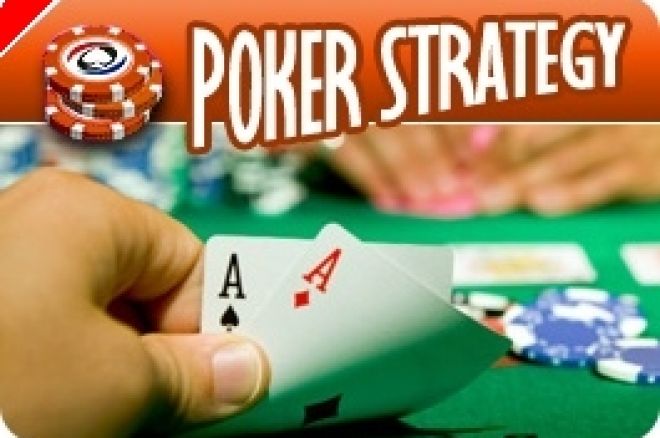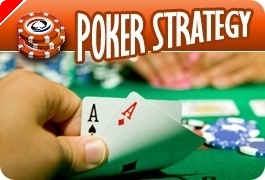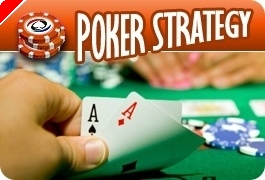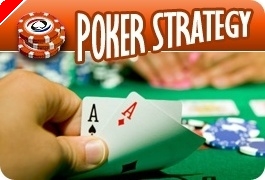Stud Poker Strategy: Big Mistakes with Big Hands

I see it all the time. The poor schlemiel in the three seat who has been calling along waiting for a big draw finally hits one. What does he do? See below.
The hand starts off five-way when a player with a queen showing raises the bring-in and four players call. On fourth street the high card, the queen, bets $20. Our friend, the schlemiel, calls with a six and nine. The player after him, with two cards to a flush, raises to $40. Everyone folds to the initial raiser, who calls.
On fifth street, the schlemiel catches a king. He's now high and checks. The player with two to a flush is next. He catches a blank but bets anyway. The queen calls as does the schlemiel.
On sixth street, the schlemiel catches a second king, giving him two exposed kings. The guy who started with two suited cards catches an unsuited ace. And the guy who started with the queen catches a blank.
The schlemiel sighs. "I still check," he says and pats his hand on the table. The other two players check behind him.
They're each dealt a river card. The schlemiel looks and checks as do the other players. They turn over their hands. The first player, showing a pair of queens, shows down two pair, queens up. The schlemiel shows down kings over sixes. And the player with the two-flush and the ace showing faces a pair of nines.
The schlemiel rakes in the pot – which is considerably smaller than it should have been had he played the hand correctly. I'm sitting next to him, have grown friendly with him as the game has progressed (he's on my left – so I've been carefully cultivating his friendship).
He looks at me, kind of sheepishly.
"You didn't like that, did you, Ashley?"
"What do you mean?" I ask innocently – though he is right that I didn't like his play at all.
"I started with that pair and then hit the kings," he notes. "But I thought the other guy might have hit Aces up so I had to check".
"I see. You were afraid he'd raise you."
"Yeah," he said. "I was afraid he'd raise my kings up – and then I'd have to call and I'd be behind and out two bets.
"I see." "Well, fortunately you won!" I added. "Nice pot".
And we played on.
I didn't clue him in on how bad his play was. I see it all the time. And I hope I continue to see it.
Let me share my thoughts with you, reader, so you'll benefit by his terrible mistakes.
First of all, he might have been correct that his opponent started with a small pair and an ace kicker. When he raised on fourth street it could have been on a pair and a three-flush headed by an ace in the hole. He might have also been slow-playing wired aces and then hit trip aces on fifth street. He might have started with trips. Many things could have been the case – things that would have made betting kings up on sixth street look mistaken in hindsight.
But poker isn't played in hindsight. And it is not a game of certainty but probability.
It was probably that the player who raised with a queen door card had a pair of queens. It wasn't definite but it was probable. And it wasn't definite but it was probable that the player who raised on fourth street with two suited cards was raising on the come with a four-flush. It was also possible that he was raising with two pair at this point – but a low two pair since he didn't have a high card.
On fifth street, when the schlemiel caught the first king and was high on board but still had only a pair of sixes, he probably did the right thing by checking. It would depend on his image. I'm guessing that his bet wouldn't have gotten either opponent to fold. So since he was behind the likely pair of queens and would most likely be leading with the high card on the following streets, his check made sense. Maybe so, too, did his call of his opponent's bet.
But on sixth street, when he caught the second king, he certainly should have bet. Similarly, on the river, when he had the kings up and his opponents had hands that were likely to be weaker (though they were possibly stronger), he should have bet.
One of the bigger problems for new, inexperienced, or otherwise mediocre stud players is their fear of what I call the "monster under the bed". They imagine a potentially huge but unlikely hand lurking and back off from what should be their aggressive bets or raises. They think, wrongly, that if a hand is possible that they should be cautious rather than bold. That fear and resulting caution costs them just as much money as improper enthusiasm or hope.
This isn't to say that there isn't a place for caution. If, for example, your opponent calls a raise on third street, catches an ace on fourth street and then initiates the betting, he may well have started with a split pair and an ace in the hole – and now has aces up. That's common. But don't be afraid that every ace you see represents a pair of aces.
Similarly, it's important to recognize the role your position must play in your decision to be aggressive or passive. If the ace-high were first to go, and you had kings up, you might well be correct to call rather than raise if he bets first. In that situation, he might be bluffing or just might not want to give you a free card. In the above example, however, where the schlemiel was first to act, his check with an exposed pair of kings opened the door for his opponent to get a free card – potentially with a four-flush – something that you generally don't want to do.
In general, if you hit an exposed pair in this situation and are likely to be up against at least one drawing hand, you don't want to check – you want to bet to force your opponent to either pay to continue or to fold. If he happens to be ahead of the hand you are representing and raises you, and you call him down, and lose two bets, you can take satisfaction in knowing that most of the time you would be making the correct move by betting. And that's what winning poker is all about.








